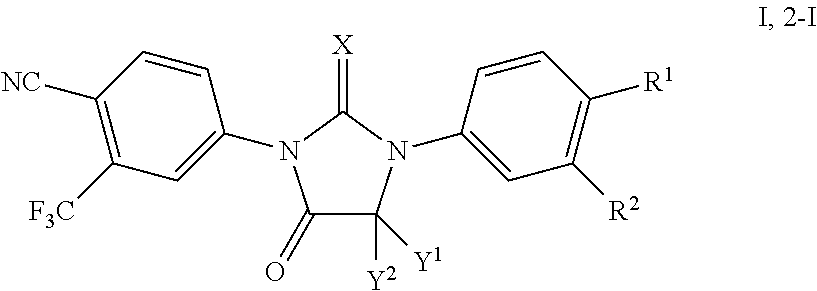Processes for the synthesis of diarylthiohydantoin and diarylhydantoin compounds
a diarylthiohydantoin and diarylhydantoin technology, applied in the field of cancer therapeutics, can solve the problems of crpc no longer responding to hormonal therapies, casodex® failing to effectively inhibit the androgen receptor in these cells, and difficult to treat, so as to reduce the effect of reducing the amount of inorganic cation and bas
- Summary
- Abstract
- Description
- Claims
- Application Information
AI Technical Summary
Benefits of technology
Problems solved by technology
Method used
Image
Examples
example 1
Conversion of 4-bromo-2-fluorobenzoic acid to 4-bromo-2-fluoro-N-methylbenzamide
[0187]
[0188]To a nitrogen flushed 50 L reactor was charged the dry benzoic acid A-1 (1.8 kg, 8.22 mol) followed by isopropylacetate (IPAc) (12.6 L, 7 vol) and DMF (36 mL, 0.02 equiv). To the stirred slurry was added thionyl chloride (689 mL, 9.47 mol, 1.15 equiv) over 5 min (batch warmed from 21° C. to 23° C.). The batch was heated to 60° C. over 2.5 h, maintained at 60-68° C. for 1 h and was sampled for HPLC analysis. The batch was a thin slurry at this point. The conversion to the acid chloride was found to be 99.9% (the acid chloride intermediate was quenched with N-propylamine prior to analysis). After stirring for an additional 1 h at 70-72° C., the batch was cooled to 10° C. over 1 h.
[0189]To a nitrogen flushed 30 L reactor was charged aqueous MeNH2 (3.6 L, 41.1 mol, 5 equiv) which was then cooled to 2-10° C. IPAc (3.6 L, 2 vol) was added to the MeNH2 and the MeNH2 / IPAc mixture was cooled to 2-10° ...
example 2
Conversion of 4-bromo-2-fluoro-N-methylbenzamide to 2-(3-fluoro-4-(methylcarbamoyl)phenylamino)-2-methylpropanoic acid
[0191]
[0192]The bromobenzamide A-2 (10 g, 43.1 mmol), aminoisobutyric acid B-1 (6.7 g, 64.6 mmol, 1.5 equiv), K2CO3 (15 g, 2.5 equiv), 99% CuCl (0.8 g, 8.1 mmol, 0.2 equiv), DMF (60 mL, 6 vol) and water (1.8 mL) were added to the flask and the reaction slurry was heated to 30° C. 2-Acetylcyclohexanone (1.14 mL, 8.1 mmol, 0.2 equiv) was added to the reaction slurry followed by stirring at 105° C. under nitrogen for 12-14 h. HPLC analysis showed 96.6% conversion to the desired product. The reaction mixture was then cooled to RT and extracted with water (120 mL) and IPAc (60 mL). The lower aqueous layer was re-extracted with IPAc (60 mL) and acidified with 180 mL of 1M citric acid to a pH of 4.0. The product began to crystallize at RT and the batch was further cooled to 5-7° C., filtered, washed with water (40 mL) and dried under vacuum at 50° C. for 12 h. The reaction ...
example 3
Conversion of 2-(3-fluoro-4-(methylcarbamoyl)phenylamino)-2-methylpropanoic acid to methyl 2-(3-fluoro-4-(methylcarbamoyl)phenylamino)-2-methylpropanoate
[0193]
[0194]A mixture of methylpropionic acid derivative C-1 (4.0 g, 15.7 mmol), potassium carbonate (2.67 g, 18.8 mmol), DMF (28 mL), and water (0.04 mL) was heated to 30° C. Methyl iodide (1.2 mL, 18.8 mmol) was then added in one portion, and a slight warming of the reaction mixture to 32° C. was observed within 5 min. The mixture was then heated to 40° C. for 1 h. HPLC analysis of the reaction mixture showed >99.9% conversion to ester product. AcOH (0.3 mL) was then added and the resulting mixture was heated to 60° C. followed by addition of water (60 mL) over 50 min maintaining a batch temperature of 58-63° C. The slurry was then cooled to 30° C., the product D-1 was then filtered, and washed with water (2×8 mL). The filter cake was re-slurried in water (40 mL) and rinsed with IPAc (2×8 mL), and dried under vacuum at 45-50° C. o...
PUM
| Property | Measurement | Unit |
|---|---|---|
| temperature | aaaaa | aaaaa |
| temperature | aaaaa | aaaaa |
| temperature | aaaaa | aaaaa |
Abstract
Description
Claims
Application Information
 Login to View More
Login to View More - R&D
- Intellectual Property
- Life Sciences
- Materials
- Tech Scout
- Unparalleled Data Quality
- Higher Quality Content
- 60% Fewer Hallucinations
Browse by: Latest US Patents, China's latest patents, Technical Efficacy Thesaurus, Application Domain, Technology Topic, Popular Technical Reports.
© 2025 PatSnap. All rights reserved.Legal|Privacy policy|Modern Slavery Act Transparency Statement|Sitemap|About US| Contact US: help@patsnap.com



